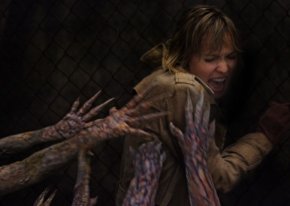|
Silent
Hill
Under mounds of studio pressure and weighted anticipation
on behalf of fandom that usually accompanies video game
adaptations, Director Christophe Gans and Screenwriter Roger
Avary have succeeded in doing what countless others have
failed to achieve.
Most
of these films are doomed (pardon the pun) before they ever
even get into pre-production. Unlike studio executives,
gamers sit countless hours on the couch, dissecting these
games from head to toe, unearthing visual cues and mythological
clues to help solve the very game they are playing.
So whenever
a video game gets slated for production, many fans brace
themselves for eventual disappointment, suppressing hopes
that it might turn out better than it actually will. Who
can honestly blame them after duds like Resident
Evil, Alone in the Dark, Tomb
Raider, Doom, Mortal Kombat,
and Street Fighter?
Some
of these titles are tough adaptations to begin with, but
survival horror entries seem tailor-made for the big screen,
only heightening the disappointment brought on by the cinematic
gutting of the franchise that ends up in cineplexes. These
games already lay out the story, mood, setting, and art
design. Most of what makes them work is the character development
-- no matter how stilted the dialogue may be at times --
which is often abandoned for a more typical Hollywood procession
of events.
Well,
not Silent Hill.
This
film is without a doubt the most faithful video game adaptation
yet, and this is coming from someone who has played a portion
of one of the games in the series at best. The sound and
visual cues taken directly from the game play perfectly
well on screen. These include shot for shot references from
games in the series, and the score, consisting mainly of
wandering single piano arrangements, follows not only the
same musical arrangements, but is used in the exact same
fashion as it is in the games.
Many
will be surprised by the look of the film. The camera is
always moving and fluid, but never really gets to the point
of being contrived or over-stylized. Shots are set up to
mirror their video game counterparts, and anyone who has
ever even looked at a Silent Hill video game will
immediately recognize the film's adherence to its source
material.
That
said, the film isn’t just a geek-off. It actually
stacks up to be one of the best horror/thriller entries
to come out of a studio in some time. Schlock-horror films
such as Saw and Hostel received notable
media attention, but Silent Hill actually has substance
to go along with its faithfulness to the franchise. Don’t
hesitate to buy a ticket if you’ve never even heard
of the video games, because what awaits you on-screen is
a no-holds-barred tale of the macabre.
Somehow
managing to convince the studios to sway from their usual
“video games are for kids, therefore video game movies
must not be rated R” mentality, Gans and Avary have
concocted a jarringly surreal experience filled with enough
subtext, gore and character development to keep fans of
all sorts enthused.
The
story centers on Rose Da Silva (Rhada Mitchell), her adopted
daughter Sharon (Jodelle Ferland), and her husband Christopher
(Sean Bean). Sharon’s past has seemingly been coming
back to haunt her in her sleep, resulting in sleepwalking
spells and utterances of the name of a town called Silent
Hill.
Rose
decides to take Sharon to Silent Hill in hopes of unearthing
some clues to her daughter's midnight fright sessions, but
her husband seems skeptical. On her way, she has a run in
with a motorcycle cop named Cybil Bennett (Laurie Holden),
who chases her after Rose flees from being pulled over.
While
on the run, Rose swerves to avoid hitting a ghostly figure
in the road and ends up losing consciousness after hitting
her head on the car steering wheel. When she wakes up, Sharon
is gone, and she discovers that she crashed on the outskirts
of the fog-laden town of Silent Hill. As she searches for
Sharon, Rose unravels clues that point to the mysterious
town's origins, and discovers that all hell seemingly breaks
loose in intervals prefaced by air raid sirens throughout
the town.
The
interesting thing to note here is, although CGI effects
are obviously used, demonic characters are not actually
left up to CG creation. Dancers in latex are used to create
these beings, and Gans even borrows tricks from the J-Horror
set by filming motions in reverse to create a more creepy
effect to their movements.
The
town’s fog is obviously processed, but viewers are
urged to debate the meaning behind the three separate planes
of reality within the film, even if answers are never fully
fleshed out.
Gans
and Avary have raised the bar on the video game adaptation
genre, but is it too late? Some of the more cherished franchises
have already suffered lackluster adaptations, it leaves
few franchises left worth giving the Silent Hill treatment.
Rating:

|








